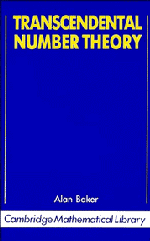Book contents
- Frontmatter
- Contents
- Preface
- 1 The origins
- 2 Linear forms in logarithms
- 3 Lower bounds for linear forms
- 4 Diophantine equations
- 5 Class numbers of imaginary quadratic fields
- 6 Elliptic functions
- 7 Rational approximations to algebraic numbers
- 8 Mahler's classification
- 9 Metrical theory
- 10 The exponential function
- 11 The Siegel–Shidlovsky theorems
- 12 Algebraic independence
- Bibliography
- Original papers
- Further publications
- New developments
- Index
2 - Linear forms in logarithms
Published online by Cambridge University Press: 01 June 2011
- Frontmatter
- Contents
- Preface
- 1 The origins
- 2 Linear forms in logarithms
- 3 Lower bounds for linear forms
- 4 Diophantine equations
- 5 Class numbers of imaginary quadratic fields
- 6 Elliptic functions
- 7 Rational approximations to algebraic numbers
- 8 Mahler's classification
- 9 Metrical theory
- 10 The exponential function
- 11 The Siegel–Shidlovsky theorems
- 12 Algebraic independence
- Bibliography
- Original papers
- Further publications
- New developments
- Index
Summary
Introduction
In 1900, at the International Congress of Mathematicians held in Paris, Hilbert raised, as the seventh of his famous list of 23 problems, the question whether an irrational logarithm of an algebraic number to an algebraic base is transcendental. The question is capable of various alternative formulations; thus one can ask whether an irrational quotient of natural logarithms of algebraic numbers is transcendental, or whether αβ is transcendental for any algebraic number α ≠ 0, 1 and any algebraic irrational β. A special case relating to logarithms of rational numbers can be traced to the writings of Euler more than a century before, but no apparent progress had been made towards its solution. Indeed, Hilbert expressed the opinion that the resolution of the problem lay farther in the future than a proof of the Riemann hypothesis or Fermat's last theorem.
The first significant advance was made by Gelfond in 1929. Employing interpolation techniques of the kind that he had utilized previously in researches on integral integer-valued functions, Gelfond showed that the logarithm of an algebraic number to an algebraic base cannot be an imaginary quadratic irrational, that is, αβ is transcendental for any algebraic number α ≠ 0, 1 and any imaginary quadratic irrational β; in particular, this implies that eπ = (–1)−i is transcendental. The result was extended to real quadratic irrationals β by Kuzmin in 1930.
- Type
- Chapter
- Information
- Transcendental Number Theory , pp. 9 - 21Publisher: Cambridge University PressPrint publication year: 1975

